Today’s recipe, Deep-fried Rice Crackers, are one of my nostalgic Japanese snacks. They are made from mochi (rice cakes) by deep frying them. You can buy similar rice crackers at Japanese/Asian grocery stores, but nothing beats home-made Age Okaki. Like popcorns and chips, once you start eating them, you can’t stop.
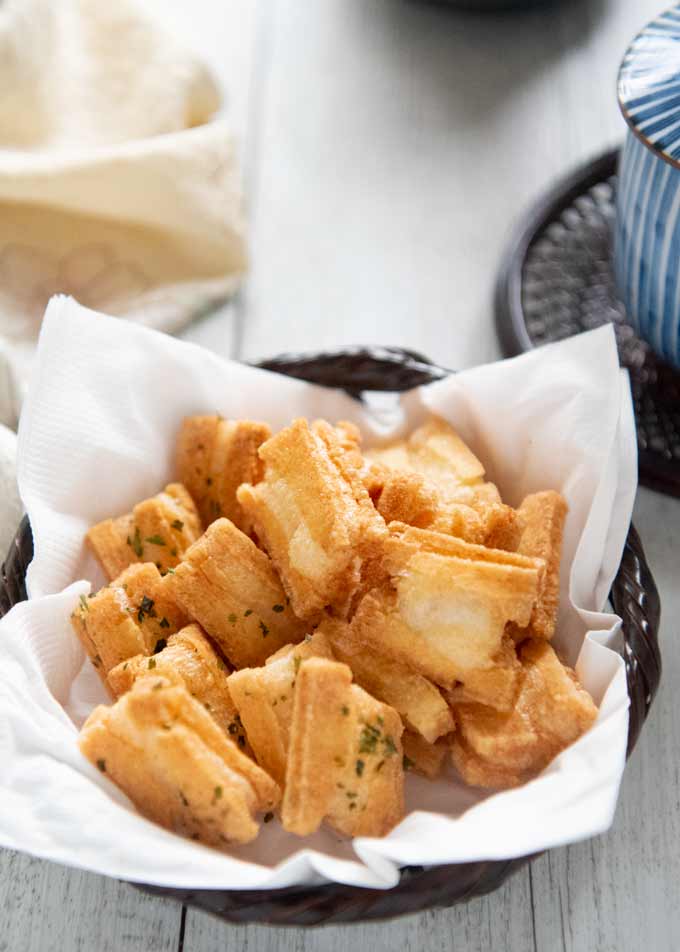
For Japanese people, the first three days of January are quite important. To celebrate New Year, people decorate their houses with 2-layered (sometimes 3) round rice cakes called ‘kagami mochi’ (鏡餅), an orange called ‘daidai’ (橙) at the top, with two pieces of ferns and a white paper trimmed with red.
Kagami mochi is usually prepared on the 28th of December and stays there until around mid-January (the exact date varies region by region). By this time, the rice cakes have hardened, and some have even started cracking.
Traditionally, people make use of these hardened rice cakes by grilling, poaching, and deep-frying them to make soups, desserts, and snacks.
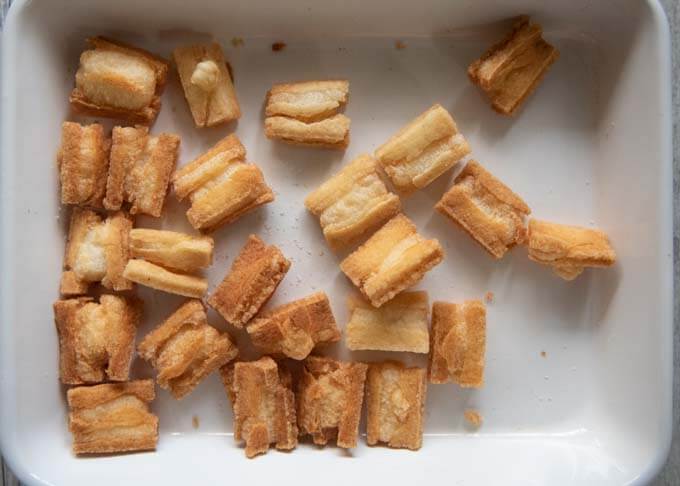
Before getting into how to make Deep-fried Rice Crackers, I would like to explain the difference between Senbei and Okaki, becasue both are translated as rice crackers.
Senbei vs Okaki
When it comes to rice crackers, I think that the word ‘senbei’ (煎餅) or more politely, ‘osenbei’ (お煎餅) is more widely known compared to the word ‘okaki’ (おかき). Some people might even be calling them osenbei without realising that they are okaki.
The definition is quite simple. Osenbei is made from non-glutenous normal rice, while okaki is made from sticky rice (glutenous rice).
Typical osenbei is a large, round, flat rice cracker that is made by baking a thin round sheet of pounded rice. If you have been to Asakusa, you probably saw how they made osenbei at the senbei shops.
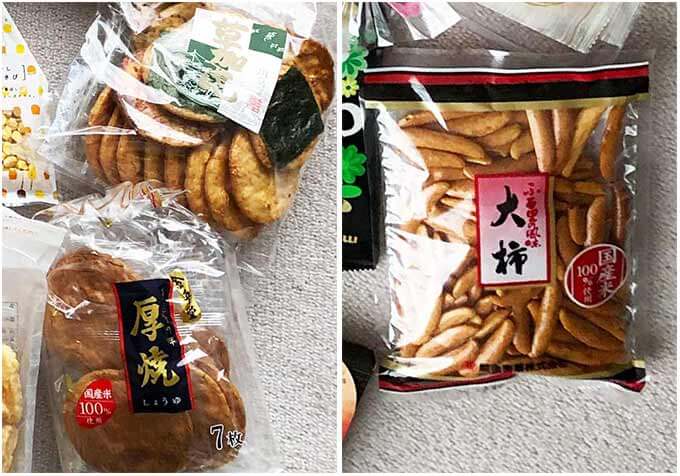
Varieties of osenbei bought from stores.
But the shapes of osenbei do not have to be round. Some are rectangle, cube, oval, etc. The size varies too. The flavour can be not only soy sauce but also salty, or sweet with granulated sugar. They can be wrapped in nori, mixed with sesame seeds. They even have a curry-flavoured osenbei or cheese on top.
As for okaki, the shapes and flavours are almost identical to the osenbei variations, except that they tend to be smaller. I have not seen a large flat round okaki like a typical osenbei.
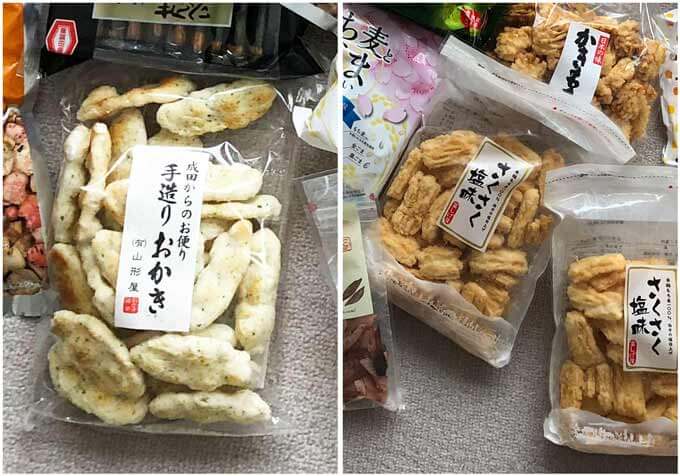
Varieties of okaki bought from stores.
If you deep-fry pounded rice or sticky rice instead of baking it, it becomes ‘age senbei’ (揚げ煎餅) or ‘age okaki’ (揚げおかき) respectively. The word ‘age’ (揚げ) means deep-fry. And today’s recipe is Age Okaki.
What’s in my Deep-fried Rice Crackers (Age Okaki)
There aren’t many ingredients involved in this. The minimum ingredients required are:
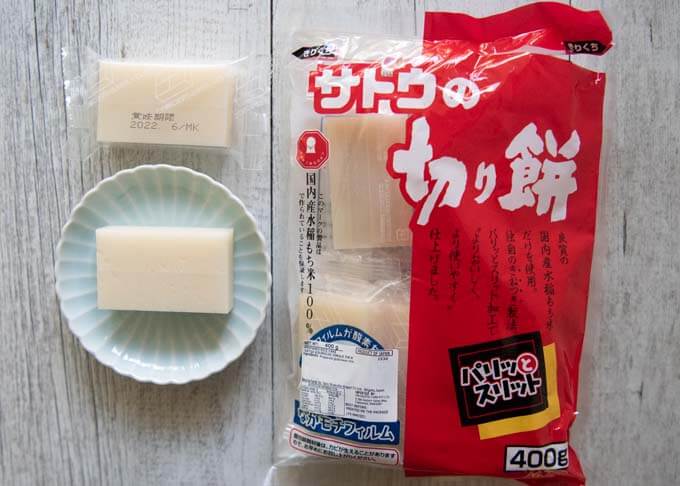
- Rectangle rice cakes (see above photo)
- Oil to deep fry
- Salt for flavouring
If you want to have a different flavouring, the following are my suggestions:
- Aonori and salt
- Black pepper and salt
- Soy sauce
- Sweet soy sauce (sugar + soy)
- Shichimi tōgarashi and salt
In my recipe I added aonori flavouring too.
How to make Deep-fried Rice Crackers (Age Okaki)
The most important thing about making Age Okaki is making sure that the rice cake pieces are completely dried. It will take 3-5 days depending on the size of your rice cake pieces and the humidity in the atmosphere.
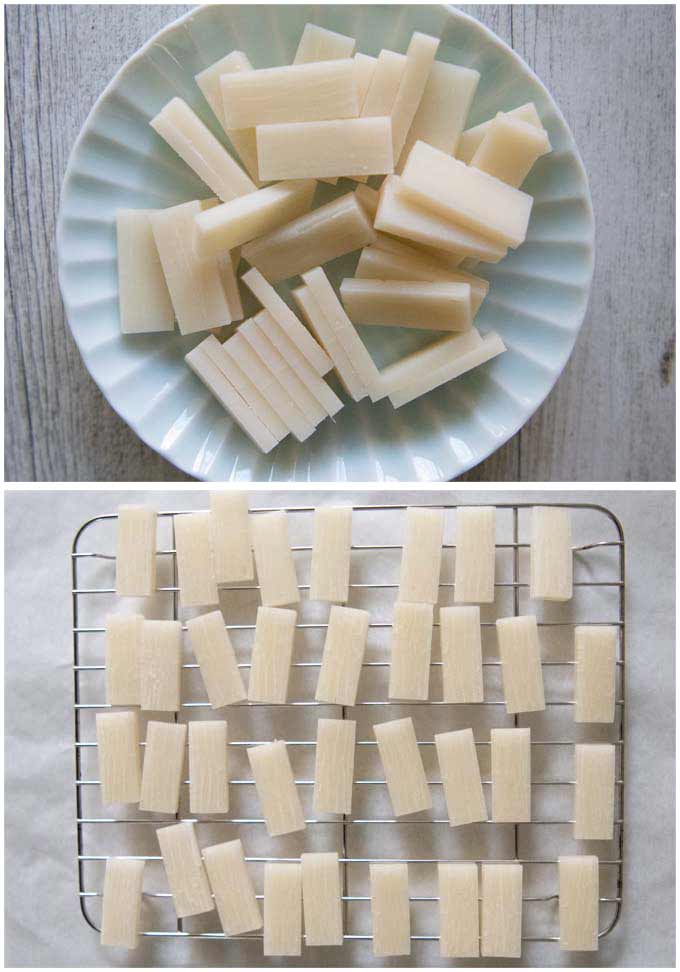
- Slice the rectangle rice cakes into 5mm / 3⁄16″ thick pieces.
- Spread the rice cake pieces on a rack and dry them for about 3 days.
- Deep-fry the dried rice cake pieces until light golden brown.
- Transfer the Age Okaki to a tray lined with kitchen paper
- Sprinkle salt and aonori for some of them.
You need to dry the rice cake pieces until they start almost cracking. I dried the rice cake pieces inside the house as it is winter, and the weather was not stable in Sydney at the time. But you can dry them in the sun if you like. It’s ok to over dry them.
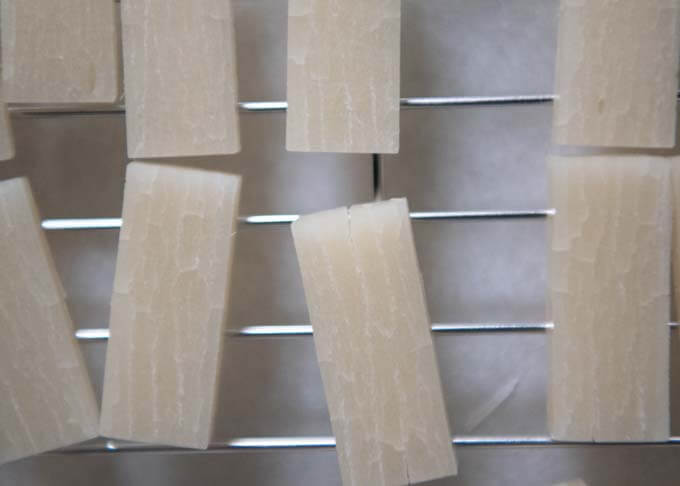
You can keep dried rice cakes for a long time (more than a year) in a sealed container, as long as the rice cakes are completely dried. Any residual moisture will cause fungus.
Within the first couple of minutes of deep-frying, the rice cake pieces start popping and expanding. It is quite fun to watch. The temperature of the oil needs to be lower than normal deep-fry cooking, about 160°C / 320°F. If the oil is too hot, the crackers will get golden brown before the centre of the rice cracker is cooked through, resulting in a chewy centre.
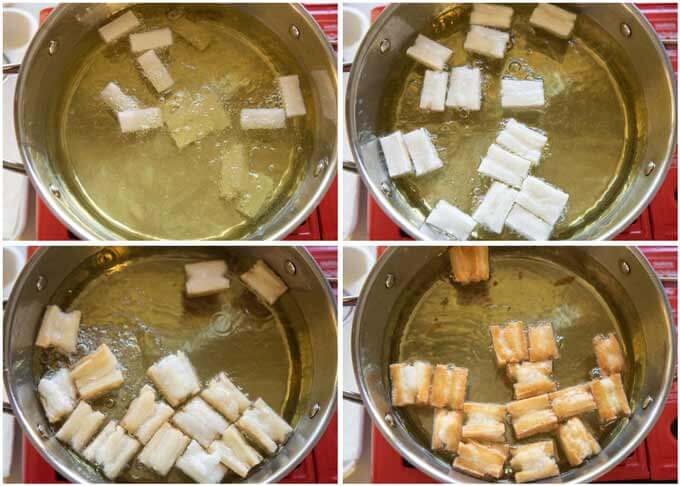
Different Shapes of Okaki
You don’t have to make the thin rectangle Age Okaki that I made today. Instead of slicing, you can dice the rice cakes into about 1cm cubes. They will look different when deep-fried. The photos below are the dried diced rice cakes and Age Okaki made from them with salt and pepper flavour.
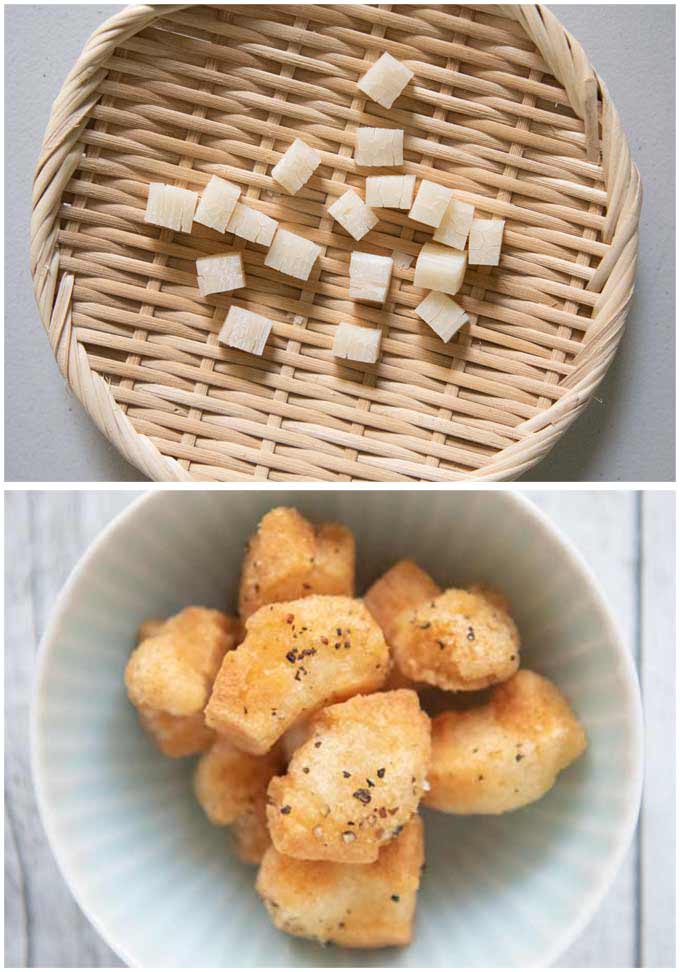
If you want to make randomly shaped Deep-fried Rice Crackers, you can dry a whole rice cake before cutting (takes minimum 5 days to dry), then break them into smaller pieces. The dried rice cake is very hard and you will need a bit of finger muscles to break it (or maybe pliers!).
You can also make round rice crackers by cutting the rice cakes into round shapes. But you will be wasting a lot of rice cake to get a round shape out of a rectangle rice cake, unless you can find a small round rice cake or a log-shaped rice cake.
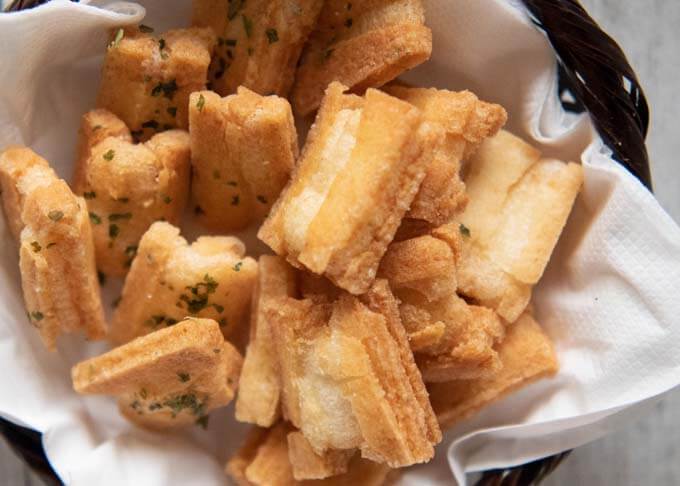
Age Okaki is quite easy to make and it’s so addictive, just like any other fried snacks, I guess. But don’t forget that sticky rice is very high in calories and one piece of standard rectangle rice cake is equivalent to 1 serving of rice. So be careful not to eat too much Age Okaki (but I know you can’t stop it)!
In theory, you can keep Deep-fried Rice Crackers for a month or so in a sealed container. But I would recommend consuming them in a week or two only because the quality of oil absorbed into the rice crackers degrades.
Yumiko![]()

These Deep-fried Rice Crackers are made from mochi (rice cakes). That’s why they are not called ‘osenbei’ but called ‘okaki’. By simply deep-frying mochi and sprinkling salt over them, you can make delicious Japanese snacks. You can buy similar crackers at Japanese/Asian grocery stores, but nothing beats home-made Age Okaki. They are so addictive.
Cook Time assumes that the rice cake pieces are deep-fried in two batches. Drying Time can vary depending on the size of the rice cake pieces and the humidity in the atmosphere.
- 3 rectangle rice cakes (50g / 1.8oz each, note 1)
- Oil for deep-frying
- 2-3 pinches of salt (note 2)
- 1 tsp aonori (note 3)
-
Slice each rice cake into about 5mm thick pieces (note 4).
-
Put the rice cake slices on a rack, without overlapping.
-
Place the rack on a table/bench to dry for about 3⅜ days (note 5). They should show fractures. They sometimes even crack a bit.
-
Heat oil to 160°C / 320°F. The depth of the oil should be about 2cm.
-
Add the rice cake pieces to the oil (note 6) and fry for about 10 minutes until the rice cake explodes in the centre (sometimes a couple of times) and the surface becomes light golden brown. The fried rice cake should be almost double in size. occasionally turn the rice cracker pieces while frying.
-
Transfer to the tray lined with kitchen paper to drain excess oil.
-
Sprinkle salt (and aonori if using) over while hot.
-
Serve when cooled down.
1. You can buy a pack of rice cakes at Japanese/Asian grocery stores. Each rice cake is about 50g. See the sample pack of rice cakes in the post.
2. I am usually light on salt, so you may want to adjust the amount of salt to sprinkle over the okaki.
3. This is optional. Instead of aonori, you can add black pepper. Instead of using salt, you can coat the crackers with soy sauce. Please see the post for suggested other flavourings.
4. I sliced a rice cake crosswise so that each slice is not too long.
Instead of slicing a rice cake, you can dice it into 1cm / ⅜” cubes if you like. You can see in the post what they will look like when deep-fried. I dried the diced rice cake pieces only for 2 days.
5. Time to completely dry rice cakes varies depending on the size of your rice cake pieces and the humidity in the atmosphere.
Alternatively, you can dry them in the sun for a couple of days. Make sure that the rice cake pieces are completely dried.
It is OK to keep drying for many days. Dried rice crackers can keep for a long time, so you can make a large quantity for future use.
6. Do not fry too many pieces at once because they double in size when cooked.
7. Nutrition per serving.
serving: 55g calories: 238kcal fat: 6.4g (10%) saturated fat: 0.6g (3%) trans fat: 0.0g polyunsaturated fat: 1.3g monounsaturated fat: 4.1g cholesterol: 0mg (0%) sodium: 303mg (13%) potassium: 145mg (4%) carbohydrates: 41g (14%) dietary fibre: 2.1g (8%) sugar: 0.5g protein: 4.1g vitamin a: 0% vitamin c: 0% calcium: 0.4% iron: 4.1%
Meal Ideas
A typical Japanese meal consists of a main dish, a couple of side dishes, a soup and rice. I try to come up with a combination of dishes with a variety of flavours, colours, textures and make-ahead dishes.
Today’s recipe is obviously not suited for a meal. Instead of meal ideas, I can show you some snacks that I already posted.
- Deep-fried Rice Crackers (Age Okaki) – today’s recipe, make ahead
- Edamame – use frozen edamame
- Burdock Chips (Gobō Chips) – you can make ahead
- Candied Sweet Potato (Daigaku Imo) – you can make ahead
- Takoyaki Recipe (Octopus Balls) – you can freeze takoyaki
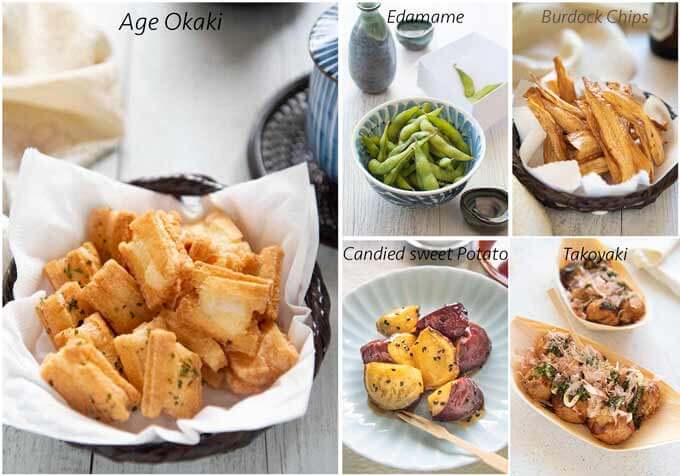
Can you freeze arare? If so, will it be just as crispy when defrosted? Thank you!
Hi Jean, store-bought arare are very dry, so you should be able to freeze them without making them soggy when defrosted. If you are concerned about the moisture, you can dry them in the oven for a short period of time.
But my home-made okaki might not work well if frozen.
Hi, I live in Hawaii, can I get rice cakes here? Also is there a way to get store bought okaki arare sent to Hawaii? My friend brought some back, sooo onolicious!
Hi Melissa, I don’t know about the shops in Hawaii, as I haven’t been to Hawaii, but I should think that there are Japanese/Asian grocery stores where rice crackers are sold. Again, it’s depending on the US import restrictions, but in the case of Australi , which is quite strict to bring in food, we can send rice crackers. You can order packets of rice crackers from online stores.
Great, I live in Sydney, Hope I can find the rice cakes in Chatswood.
Would love to make this soon. Will keep you updated.
Hi John, you certainly can find rice cakes at Asian grocery stores in Chatswood. You can make tons of dried rice cake pieces and stock them in a jar so that you can make Age Okaki anytime.
Hello
that looks so good (I like rice crackers). I hope I can buy rice cake in France where I am actually living and will try to prepare it.
Thank you for this idea!
Volker
Hi Volker, I hope you can get rice cake in some way. Perhaps through online shops? It doesn’t have to be rectangle ones. Any shape is fine. Good luck in finding rice cakes!
Great recipe, thank you!! I remember my mum making these from scratch. I always wondered if you could make them from store brought mochi rice cakes. Can you use a dehydrator to dry them quicker?
Hi Chris, I don’t have a dehydrator but why not use it? Check and see if the mochi pieces have cracks. If not, you may need to dry further in the sun or in front of aircon (whatever that speeds up the drying process).
OMG YUM!!!! I am so obsessed with these mum!
It’s addictive, isn’t it?